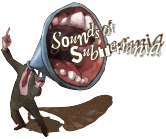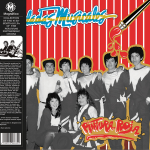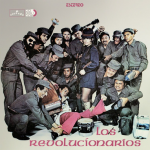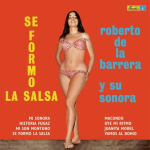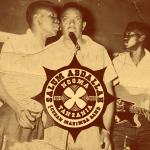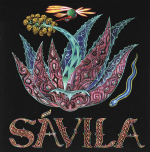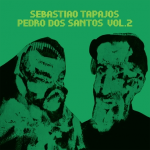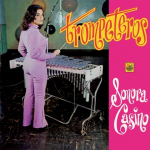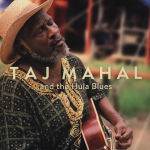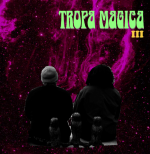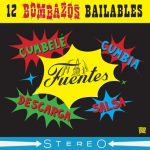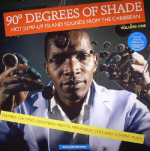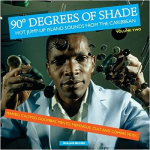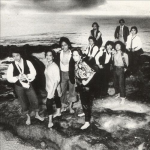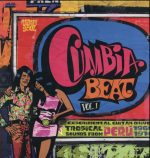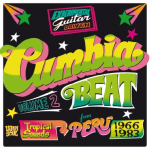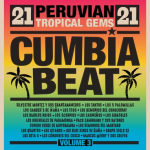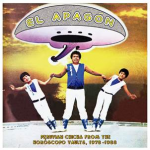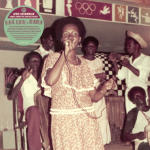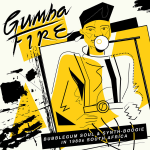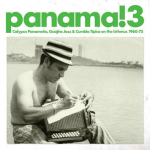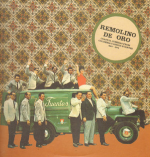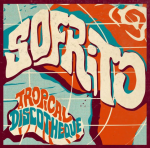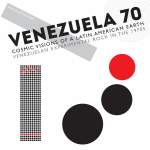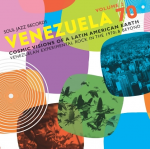Katalog
Suchergebnisse
- 01. Pintura Roja - El Teléfono
02. Sola
03. Petiso
04. Te Olvidaste
05. Recuerdos
06. Oh Virgen María
07. Padre Olvidado
08. El Chinito Nº 2
09. Ayúdame Tu.
10. Pintura Roja - Pinceladas MusicalesPINTURA ROJA
Pinceladas Musicales
[engl] The nickname is superb, as unappealable: The University of Chicha. It is not an exaggeration that, 32 years after the release of Pinceladas Musicales, their second LP, the cumbia band Pintura Roja continues to be recognized as a monumental institution in the history of Peruvian music. Since its foundation in 1984, Pintura Roja has served as the quarry of the greatest exponents of "chicha" music, cultivating in the classrooms of its academy artists like Princesita Mily, considered one of the first women to integrate a chicha band, and Muñequita Sally, the disappeared queen of Andean folk, in addition to the legendary vocalist Toño Centella and the remembered Jhonny Orosco, founder of Grupo Néctar. Pintura Roja is revolution, innovation, success. It is a commitment to originality, as well as a history of defections and tragedies. But above all, Pintura Roja is Alejandro Zárate Espinoza, its founder, director, composer and lead guitarist. He’s "The Gentleman of Cumbia". In 1984, Pintura Roja is called by Discos Horóscopo to record an LP before the end of the year. The group begins to capture the attention of the public, otherwise, curious about the voice of a woman that they initially confuse with the voice of a child, or perhaps attracted to their lyrics that reflected the dramas and common situations experienced daily by migrants and their first generations in Perú’s capital: the abandonment of parents and sentimental counterparts, the incipient poverty and the uncertain present in which they lived. The woman as a fighter, capable of facing alone adversity and triumphant over sexism, appears in some songs, giving it greater relevance the fact that a woman with the power that her voice gave her, sang to them from the top of the stage. In 1985, Pintura Roja gained popularity on the radio and acquired a one-hour program on Radio Inca called "Pinceladas Musicales". That year, readers of the newspaper El Popular choose it as the favorite band of the year. It is for the second production that Zárate decided to seek support for Mily, who at that time danced and sang for up to six hours in each presentation. Zárate signs Sara Barreto, a 14-year-old huayno singer known as "Natachita", and gives her a new artistic name: La Muñequita Sally.- Format
- DoLP
- Release-Datum
- 22.03.2019
- EAN
- EAN 8517441224497
- A1 Perdoname Leandro
A2 Esa Mulata
A3 Caribe
A4 Los Carasucias
B1 Salsa De Monte Adentro
B2 La Mezcla
B3 Toro Barcino
B4 Josefina
B5 Bajo El Palo ‘E MangoREVOLUCIONARIOS, LOS
Last Band Standing
[engl] A revolutionary album with a sound unlike that of any other tropical record before or after which could only have come from the Caribbean region of Colombia and the fertile mind of the band's leader, Alfredo Gutiérrez. What makes this record unique and a highly sought-after collector's piece are the innovative arrangements that mix a sax section with electric organ, piano and accordion, and its killer version of Javier Vázquez's hard salsa tune `Esa mulata'. The rest of the album has more hot salsa, boogaloo and descarga, plus local flavors like paseo and porro and even a Dominican merengue. Presented in facsimile artwork and pressed on 180g vinyl. Part of a new Vampisoul reissue series of classic LPs from Colombia's Codiscos and its group of labels such as Zeida and Costeño.- Format
- LP
- Release-Datum
- 24.05.2019
- EAN
- EAN 8435008863364
- 01. Macondo
02. Mi sonora
03. Vamos al bohío
04. Oye mi ritmo
05. Historia fugaz
06. Juanita Morel
07. Se formó la salsa
08. Mi son montunoROBERTO DE LA BARRERA Y SU SONORA
La clavada
[engl] Colombia has produced many fine pianists in the Antillean traditions rooted in Cuban music. Discos Fuentes had its share of geniuses that tickled the 88s in the salsa idiom, yet most of them, even when headlining an orchestra, remain unknown or relatively obscure outside of collector’s circles. Such is the case of Roberto de la Barrera, who not only cut several LPs under his own name for the label but also was an uncredited session pianist and arranger on various other Fuentes records. De la Barrera did not hail from the commercial centers of the interior like Bogotá or Medellín, nor did he come from the “salsa capital” of Cali or even the port of Buenaventura where so many Cuban and Puerto Rican records first entered the country. His birthplace was the Caribbean city of Cartagena, which, along with Barranquilla and Santa Marta, forms an area with its own rich musical traditions like the cumbia and porro, but also was one of the first regions in Colombia to feature imported Antillean genres like mambo, cha cha cha and pachanga. Also, significantly, Cartagena was the original home of Discos Fuentes before it moved to Medellín, and is the birthplace or initial stomping ground of other important figures in the salsa idiom like Joe Arroyo, Michi Sarmiento, Joe Madrid, Johnny Moré, Víctor del Real, Juan Carlos Coronel, Joseíto Martínez and Hugo Alandete.Roberto de la Barrera was arguably the first cartagenero to record music that would later be labeled “tropical” and “salsa” with his group Roberto de La Barrera y su Sonora, starting off with cumbia, porro, charanga and pachanga in the early to mid-1960s, and ending the decade with guaguancó, guaracha, descarga and son montuno, leaving a handful of gems for posterity, such as ‘El baile de los cocacolos’, ‘Vamos a guarachar’ and ‘Se formó’ from the earlier period and ‘Se formó la salsa’, ‘Mi sonora’ and ‘Oye mi ritmo’ as the 1970s began. After taking the piano seat in the Discos Fuentes house orchestra and being hired in 1964 by label boss Antonio Fuentes as the regional musical director in the Caribbean area (based in Cartagena), where he subsequently discovered, signed and produced a lot of local talent, the following year Roberto de la Barrera y su Sonora recorded “Pa’ Los Cocacolos”, his first long play under his own name for the label, succeeded by “¡Pa’ cumbanchar!” and finally “Se formó la salsa” in 1970.All of his arrangements feature an interesting mix of Colombian and Cuban flavors, sometimes within the same tune, and often with that wonderful raw, loose, improvisational quality associated with the “descarga” jam sessions of Cachao and others a decade before. Perhaps the best example of this is ‘Mi sonora’ from “Se formó la salsa”, where the vocalist Felipe Sembergman actually name-checks New York’s famous Village Gate, home of many Latin jazz and salsa concerts at the time, thus making the connection explicit between what was beginning to catch on in Colombia as “salsa” and its New York Latin roots. Whatever the case, immediately in Roberto de la Barrera’s wake, a whole slew of groups from the coastal regions started performing in this style, like Michi y Sus Bravos (where Felipe Sembergman was a featured vocalist), Orquesta La Protesta (with a young Joe Arroyo), El Afrocombo, Los Caporales del Magdalena, Los Corraleros de Majagual, Lisandro Meza y su Combo Gigante, Los Revolucionarios, Julián y su Combo, Peregoyo y su Combo Vacaná, and Juan Piña con La Revelación. Not to mention what was starting to happen in the interior with Fruko y Sus Tesos, Sexteto Miramar and others, which was influenced by de la Barrera as well. Sometimes the Colombian “salsa” sound was mixed, at other times the genres were kept separate, but a certain Caribbean aesthetic carried its way through everything these artists did, and Roberto de la Barrera was a pioneer in introducing modern Latin sounds from Havana, New York and San Juan. After his stint with Fuentes, Roberto teamed up with his brother Raúl de la Barrera, managing the recording facility and record label Ecos, which released several singles on 78 and 45 from Roberto’s Orquesta Ecos, accompanied by the voice of Tony Zúñiga, as well as Los Ídolos de Palenque and the sought-after track ‘Sabrosón’ credited to Roberto de la Barrera y su Piano Mágico. Sadly, the contributions of Roberto de la Barrera in bringing salsa to the Caribbean region of Colombia and hence the rest of the country have gone largely unheralded but hopefully this reissue of “Se formó la salsa” will help set things straight.- Format
- LP
- Release-Datum
- 15.11.2019
- EAN
- EAN 8435008863531
- 01. Marumba Cha Cha
02. Kindimwanga
03. Beberu
04. Masikitiko
05. Asiye Bahati Duniani
06. Moyo Koma
07. Cuba Cha Cha
08. Kutenda Maovu
09. Ngoma Iko Huku
10. Njoo Haraka
11. Naumiya
12. Macho LainiSALUM ABDALLAH AND CUBAN MARIMBA BAND
Ngoma Tanzania
[engl] Sweet and joyful sounds from the first half of 1960’s Tanzania. Salum Abdallah and Cuban Marimba Band were at the forefront of “muziki wa dansi”, the emerging dance music scene influenced by Cuban 78’s, crazes like the twist and cha cha cha, and the local sounds of their home country. Hailing from the town of Morogoro, they rose to be stars across the country. Out of over 100 sides recorded for local labels, mostly Mzuri Records of Kenya, these twelve songs are the cream of the crop. Only a few of these have ever been re-released in any form, and that hasn’t happened in eons. Lots of toe tappers, smile enhancers, and downright dancers, with a few slower and sweeter songs to round it out. Taken from 1961-65, these twelve songs shine a brighter light on an already bright light that was Salum Abdallah, taken away from this earth all too early at the age of 37. The 12 song LP comes in an old style tip-on sleeve with lyrics in Swahili with English translations on the inner sleeve. Released by our friends at Domino Sound in New Orleans.- Format
- LP
- Release-Datum
- 01.01.2019
SAVILA
Mayahuel
[engl] Sávila is a medicinal plant that grows wild in tropical climates all over the world as well as the name of cumbia/latin/world/r&b inspired music and visual art project by guitarist Fabiola Reyna, vocalist Brisa Gonzalez and percussionist extraordinaire Papi Fimbres. MAYAHUEL is the follow up to their self-titled debut LP and further explores Sávila's singular melding of cumbia, dream-pop, spirited vocals, hallucinatory riffing and driving percussion. “MAYAHUEL is based on time spent before the pandemic immersed in the music, traditions, people and environment of that beautiful place. Lots of these songs are integrated with field recordings from musicians we met along the way, incorporating pre-hispanic percussion elements and field recordings taken from the streets during our time there. Meant more as a reflection on what we encountered though some songs evolved into something more elaborate as we explore the genre of ancestral club. Music for our ancestors made for the club.” - Sávila- Format
- LP
- Release-Datum
- 07.05.2021
- 01. Ganga
02. Dora/Saudade Da Bahia
03. Catedral
04. Feitiço Da Vila
05. Laberinto
06. Escola De Samba
07. Samba Do Aviáo
08. Feitio De Oraçao
09. Emboscada
10. Rio Das Ostras
11. Tornei A Caminhar
12. SambadenSEBASTIÃO TAPAJOS AND PEDRO DOS SANTOS
Vol. 2
[engl] The ION studios, located in the Buenos Aires neighborhood of Balvanera, have been the usual setting for recordings by Argentine artists as popular as Les Luthiers or Charly García. In the early 1970s they also hosted Brazilian guitarist Sebastião Tapajos for several sessions accompanied by other musicians such as Arnaldo Henriques, Maria Nazareth or Pedro "Sorongo" Dos Santos. Two albums would be published in the Argentine record label Trova of the recordings along with the latter.In this "Vol.2" the connection between the delicate guitar of Tapajos and the surprising experimental percussion of Pedro Dos Santos, based on unusual objects such as spoons, deodorant containers or matchboxes, creates extraordinary beauty throughout the 12 songs on the album. The sound of the flute is another of the ingredients present in several of the songs and, although his actual involvement is not confirmed on the sleeve credits of the album, everything seems to indicate that Danilo Caymmi was the musician invited to accompany the Tapajos-Dos Santos duo.Since its first release in 1972, this album has been highly sought after by all Tapajos fans, both inside and outside Brazil, becoming a title hard to get hold of due to the fact that it was initially only published in Argentina. Years later, when Brazilian rhythms were incorporated, along with jazz, to the spectrum of sounds regularly played at London clubs, by DJs such as Gilles Peterson or Paul Murphy, a renewed interest in this album arose as it includes the killer dancefloor tune 'Tornei a caminhar', an amazing samba funk number. But the general vibe of this solid album is driven by an exquisite and delicate dialogue between the guitar of Sebastião Tapajos and the rhythmic approach provided by Pedro Dos Santos that generates ambiences of unusual beauty and depth. From the personal approach to Jobim's classic 'Samba Do Aviao' to the energetic and fast paced 'Ganga', the album opening song, the mysterious beauty of 'Rio Das Ostras' to the cinematic moods of 'Ambush' (bossa meets action film music?), this “Vol. 2 ”is absolutely wonderful from beginning to end. It is a necessary complement to the much hailed Pedro Dos Santos album “Krishnanda” in the collection of anyone with an interest in the most adventurous sounds of Brazil and also an essential work in the discography of Sebastião Tapajos.- Format
- LP
- Release-Datum
- 17.01.2020
- 01. El negro Javier
02. Pasa, pasa
03. Trompeteros
04. Bobby
05. Astronautas a Mercurio
06. El turrón de Pochita
07. Guajira del amor
08. Serrano
09. Cancha, Mote y Papa
10. Pal' gusto
11. El culantroSONORA CASINO
Trompeteros
[engl] Hugo Macedo was a member of the first sonora in Peru, directed by his brother: the Sonora de Lucho Macedo. His brothers were the singers of the band while he performed as a timbalero. After nine years he founded the Sonora Casino of Hugo Macedo in 1964, later incorporating his wife, Lucía "Pochita" Rivera as a vocalist.“Trompeteros” was released on the Peruvian record label MAG in 1972. Previously, the Sonora Casino had already recorded several albums for Philips since the mid-60s. At the time their repertoire was fed by rhythms such as cha cha cha, bolero, guaracha... Their MAG period would start in 1970 with the album “Pochita y la Sonora Casino de Hugo Macedo” in which Hugo Macedo's wife was granted with an important visual presence on the front cover, with a similar follow-up on “Trompeteros”, creating some confusion since vocalist Pachito Nalmy was the actual main singer on the record. The vocalist, who hails from Callao, demonstrates here a great vocal versatility as captured on songs like 'Guajira del amor', with a heavy rhythm that will surely delight boogaloo lovers, or the bolero number 'Pasa, pasa', being both songs own compositions of the multitalented Nalmy.Guarachas, descargas and cumbias complete the offering of this fantastic album, one of the strongest tropical LPs in the MAG catalogue. But the real banger here is the almost magical 'Astronauts to Mercury', a cosmic descarga full of electronic effects, filtered voices and fierce guitars with wah wah and raw distortion, closer to the sound of any psychedelic recording than the classic tropical sound of La Sonora Casino, and right next to those elements, an impressive brass section that boosts the intensity of the song to the highest levels. It is not surprising that “Trompeteros” has become in recent years a highly sought-after album not only by Latin music collectors but also by those after the most exotic and experimental psychedelic sounds around...- Format
- LP
- Release-Datum
- 17.01.2020
- EAN
- EAN 8435008863609
TAJ MAHAL
And The Hula Blues
Zwölf Jahre lebte Taj Mahal auf Hawaii, bevor er 1996 zurück nach Los Angeles zog. Dass ihm diese Entscheidung nicht leicht fiel, steht zwischen den Zeilen seines "Hula Blues"Projektes. Dabei ist die Annäherung an andere kulturelle Traditionen für Taj Mahal nichts Neues. In jüngerer Zeit war er an diversen "crosskulturellen" Projekten beteiligt: es gab Begegnungen mit dem Westafrikaner Ali Farka Toure, dem Inder Vishwa Mohan Bhat und anderen. Sechs der acht Mitmusiker auf "And The Hula Blues" stammen von Hawaii, das Instrumentarium ist typisch hawaiianisch: verschiedene Ukulelen, Slack-Keygitarre und hawaiianische Steel-Gitarre. Der besondere Geist schwingt in jedem Titel mit. Natürlich durfte auch einer der vielen MahalKlassiker - in diesem Falle der "Mailbox Blues" - nicht fehlen. Geradezu entrückt gleitet die Band durch das Instrumental "Sacred Island", während "The Calypsonians" oder "Coconut Man" feingesponnene PopQualitäten aufweisen. Der "Hula Blues" à la Mahal - ein Höhepunkt in Taj Mahals üppiger Diskographie.- Format
- LP
- Release-Datum
- 15.11.2013
- EAN
- EAN 4015698187014
- 01. Lady Magoo
02. Cohen's Cumbia
03. Price Of Life
04. Cumbia Mamon
05. Todo El Dia
06. Tu Y El Alcohol
07. Mascarita
08. Sonora Distance
09. Wampiro
10. Ven Como Eres
11. MisirlouTROPA MAGICA
III
[engl] The East L.A. duo made a name for themselves by combining alternative, grunge, and psychedelic rock with cumbia — a danceable genre that originates from Colombia and is typically grouped with tropical sounds like salsa, merengue and bachata, among many. But Tropa Magica expands that sound by featuring diverse instruments and incorporating bossa nova, surf rock and disco. This one is the European edition on crystal purple vinyl and 2 extra tracks.- Format
- LPcol
- Release-Datum
- 13.05.2022
- EAN
- EAN 0791689 448398
- 01. Lito Barrientos y su Orquesta - Cumbia en Do menor
02. Lisandro Meza y su Combo Gigante - Arrebatá
03. Combo Los Yogas - Coco May May
04. Peregoyo y su Combo Vacaná - La pluma
05. Adolfo Echeverría y su Orquesta - Sabroso bacalao
06. Pedro Laza y sus Pelayeros - Lindo Magdalena
07. Fruko y sus Tesos - El vidriero
08. Los Supremos - Atiza y ataja
09. Conjunto Miramar - Cumbia loca
10. Michi Sarmiento y su Combo Bravo - Manué
11. Tita Duval y el Nuevo Ritmo de Bobby Rey - Safari Safari
12. Sexteto Miramar - Mambo flamencoV/A
12 BOMBAZOS BAILABLES
[engl] Discos Fuentes, the renowned Colombian record label, home to some of the best tropical recordings ever made, turns 85 this year, becoming the longest running independent music company in the World! Their vast catalogue comprises many different tropical genres, from cumbia or boogaloo to hard salsa, cumbelé or bomba, becoming an essential reference point for any Latin Music aficionado.Vampisoul started the on-going Discos Fuentes reissue series in early 2017, making some of the most solid and highly sought-after titles available again, presented in facsimile artwork and pressed on 180g vinyl. Many of our reissues have become instant collector items as the demand was big due to the extreme difficulties of getting hold of original clean copies and the very high prices paid for them.We have now put together a collection of 12 top dancefloor oriented songs, as a taste of and introduction to our reissue series and as a celebration to the 85 anniversary of Discos Fuentes. It includes tracks by the likes of Fruko y sus Tesos, Michi Sarmiento y su Combo Bravo and Lito Barrientos y su Orquesta, and also lesser known artists whose legendary recordings have become classic DJ spins in the tropical sounds scene over the years. Every track is a winner!- Format
- LP
- Release-Datum
- 17.01.2020
- EAN
- EAN 8435008863562
V/A
90 Degrees Of Shade Vol.1
Die Juwelensammler von Soul Jazz haben sich mal wieder durch die Archive gegraben. Zielort waren dieses Mal die karibischen Inseln zwischen Kuba, Jamaika, Haiti, Puerto Rico und Dominikanischer Republik. Dort haben sie 32 Mambo-, Calypso-, Goombay-, Mento-, Merengue-, Cult- und Compas-Stücke gefunden, die sie uns - wie es nun mal glücklicher Weise so ihre charmante Art ist - nicht vorenthalten wollen. Ihr Ergebnis präsentieren sie unter dem Titel "90 Degrees Of Shade. Hot Jump-Up Island Sounds From The Caribbean". Das Album erscheint als Deluxe-2CD-Box mit überdimensionalem und gewohnt informativem Booklet und als zweifache limitierte Doppel-LP mit Klappcover, 180-g-Vinyl und Downloadcode. Darauf geboten wird ein heißes Gebräu der 1950er und 60er Jahre. Einer Zeit, als in der Karibik viele Staaten ihre Unabhängigkeit erlangten und ständig neue musikalische Stile kreiert wurden. Flankiert wird die Veröffentlichung im Übrigen durch den großformatigen Bildband "90 Degrees Of Shade: 100 Years Of Photography In The Caribbean (With Foreword By Paul Gilroy)".- Format
- LP
- Release-Datum
- 28.11.2014
- EAN
- EAN 5026328002903
V/A
90 Degrees Of Shade Vol.2
Die Juwelensammler von Soul Jazz haben sich mal wieder durch die Archive gegraben. Zielort waren dieses Mal die karibischen Inseln zwischen Kuba, Jamaika, Haiti, Puerto Rico und Dominikanischer Republik. Dort haben sie 32 Mambo-, Calypso-, Goombay-, Mento-, Merengue-, Cult- und Compas-Stücke gefunden, die sie uns - wie es nun mal glücklicher Weise so ihre charmante Art ist - nicht vorenthalten wollen. Ihr Ergebnis präsentieren sie unter dem Titel "90 Degrees Of Shade. Hot Jump-Up Island Sounds From The Caribbean". Das Album erscheint als Deluxe-2CD-Box mit überdimensionalem und gewohnt informativem Booklet und als zweifache limitierte Doppel-LP mit Klappcover, 180-g-Vinyl und Downloadcode. Darauf geboten wird ein heißes Gebräu der 1950er und 60er Jahre. Einer Zeit, als in der Karibik viele Staaten ihre Unabhängigkeit erlangten und ständig neue musikalische Stile kreiert wurden. Flankiert wird die Veröffentlichung im Übrigen durch den großformatigen Bildband "90 Degrees Of Shade: 100 Years Of Photography In The Caribbean (With Foreword By Paul Gilroy)".- Format
- LP
- Release-Datum
- 28.11.2014
- EAN
- EAN 5026328102900
V/A
Aloha Got Soul
Dass Hawaii weitaus mehr zu bieten hat als den Iron Man, Surferstrände und Vulkane, stellt die Kompilation "Aloha Got Soul: Soul, AOR & Disco in Hawai'i 1979-1985" eindrucksvoll unter Beweis. Die beim Londoner Label Strut erscheinende CD ist der weltweit erste Sampler, der sich der hawaiianischen Tanz- und Popmusik der späten 70er, frühen 80er annimmt. Für die einheimischen Künstler war diese Zeit eine fruchtbare Ära: Einerseits wurde Hawaiian 1978 zur offiziellen Inselsprache, wodurch eine dynamische Künstlerbewegung entstand, die Hula und traditionelle Musikstile mit neuem Leben füllte; andererseits buchten Veranstaltungsorte mit Musikprogramm aus Kostengründen die Künstler der Insel. "Aloha Got Soul" wurde von Roger Bong kompiliert, der seit Jahren einen Blog rund um den Themenkomplex "Hawaiianischer Soul, Funk, Jazz und Artverwandtes" betreibt, leidenschaftlicher Vinyljäger ist und schlicht als der Experte für gute einheimische Musik gilt. Für die Zusammenstellung hat Bong 16 rare Tracks aus seinen Plattenkisten gezaubert, die überwiegend bislang nur auf Originalvinyl in Hawaii erschienen sind. Das umfangreiche Booklet führt mit einem ausführlichen Begleittext, Künstlerinterviews, zahlreichen Fotos und Cover-Abbildung umfassend ins Thema ein. Wer den Sound von Gilles Person, Earth Wind & Fire, Tower Of Power, Doobie Brothers, Roy Ayers oder Donald Fagen mag, sollte hier mal ein Ohr riskieren.- Format
- DoLP
- Release-Datum
- 18.03.2016
- EAN
- EAN 730003313318
V/A
Cumbia Beat Vol.1
[engl] Originally released in 2010. Available again after several years out of print. Cumbia and Chicha ! Experimental Guitar-driven Tropical Sounds from Peru 1966-1978. In 1960s Peru, a thrilling and unstoppable style of music is born: Peruvian cumbia, also known as "chicha". Tropical genres such as merengue, guaracha, rumba and cumbia mix with 60s beat and psychedelic rock, while electric guitars reinterpret folk melodies and traditions from the Andes and the Amazonian jungle, in a musical representation of the exodus from rural areas to Lima and other big cities. First volume of a new series dedicated to documenting this most exciting and popular genre. In mid-50s Peru, mambo was progressively replaced by preferences for other rhythms like merengue, guaguancó, cha cha cha, joropo, guaracha, rumba and cumbia, which timidly begins to sound during these years. In Lima it's the golden age of great orchestras and music ensembles which are capable of playing swing and jazz, but especially the diverse tropical variants inundating the market. The most successful of all, La Sonora de Lucho Macedo, released in 1965 an LP consisting exclusively of cumbia. Around this time, the successful folklore group Los Pacharacos released the album "Los ídolos del pueblo", which included a cumbia number in the middle of the potpourri of huaynos, waltzes and polkas. The marriage between folklore and cumbia had taken place. The groups preserved the fusion of fox trot and mambo rhythms along with huayno and cumbia in the execution of their music. That feeling would be the basis for the success of such unorthodox and unclassifiable songs as 'La chichera' or 'Petipan'. The recording in 1965 of these two songs by Los Demonios del Mantaro on a seminal 45 rpm with the Sono Radio label was the jumping off point for the birth of cumbia andina, also called "chicha" precisely for this song, which is dedicated to a vendor of the well-known Incan liquor. The electric shock of rock guitars enters the world of cumbia in 1968. The cause of such copulation was Enrique Delgado Montes, regarded as the genre's godfather. He did it, as part of his band Los Destellos, on a 45 ('El avispón' / 'La malvada') and an eponymous LP. His songs constitute the most surprising musical fusions and amalgams of the time: whether they merge Cuban music and psychedelia, explore the sounds of Andean or Amazonian music, combine the digitalization of the Creole guitar with huayno melodies or abuse fuzz tones and distortion pedals with enormous strength. The metamorphosis of cumbia turns it into a genre that seems to voraciously cannibalize acoustic traditions and modern technologies. There wasn't an innovation that tropical guitarists didn't add to their sound: delay, fuzz tone, overdrive, wahwah, reverb, modulating effects typical of rock bands are assimilated into a stunning sonic cocktail. In this context, cumbia reached the top of the charts in popularity. Cumbia replaced rock as the urban sound. The groups would slowly develop an ethnic sensibility inspired by native Shipibo motifs and an astonishing and bewitching sound that seemed to drink from all the mysteries, secrets and myths of the jungle.- Format
- DoLP
- Release-Datum
- 07.05.2010
- EAN
- EAN 8435008862114
V/A
Cumbia Beat Vol.2
[engl] Originally released in 2010. Available again after several years out of print. Cumbia and Chicha ! Experimental Guitar-driven Tropical Sounds from Peru 1966-1978. In 1960s Peru, a thrilling and unstoppable style of music is born: Peruvian cumbia, also known as "chicha". Tropical genres such as merengue, guaracha, rumba and cumbia mix with 60s beat and psychedelic rock, while electric guitars reinterpret folk melodies and traditions from the Andes and the Amazonian jungle, in a musical representation of the exodus from rural areas to Lima and other big cities. First volume of a new series dedicated to documenting this most exciting and popular genre. In mid-50s Peru, mambo was progressively replaced by preferences for other rhythms like merengue, guaguancó, cha cha cha, joropo, guaracha, rumba and cumbia, which timidly begins to sound during these years. In Lima it's the golden age of great orchestras and music ensembles which are capable of playing swing and jazz, but especially the diverse tropical variants inundating the market. The most successful of all, La Sonora de Lucho Macedo, released in 1965 an LP consisting exclusively of cumbia. Around this time, the successful folklore group Los Pacharacos released the album "Los ídolos del pueblo", which included a cumbia number in the middle of the potpourri of huaynos, waltzes and polkas. The marriage between folklore and cumbia had taken place. The groups preserved the fusion of fox trot and mambo rhythms along with huayno and cumbia in the execution of their music. That feeling would be the basis for the success of such unorthodox and unclassifiable songs as 'La chichera' or 'Petipan'. The recording in 1965 of these two songs by Los Demonios del Mantaro on a seminal 45 rpm with the Sono Radio label was the jumping off point for the birth of cumbia andina, also called "chicha" precisely for this song, which is dedicated to a vendor of the well-known Incan liquor. The electric shock of rock guitars enters the world of cumbia in 1968. The cause of such copulation was Enrique Delgado Montes, regarded as the genre's godfather. He did it, as part of his band Los Destellos, on a 45 ('El avispón' / 'La malvada') and an eponymous LP. His songs constitute the most surprising musical fusions and amalgams of the time: whether they merge Cuban music and psychedelia, explore the sounds of Andean or Amazonian music, combine the digitalization of the Creole guitar with huayno melodies or abuse fuzz tones and distortion pedals with enormous strength. The metamorphosis of cumbia turns it into a genre that seems to voraciously cannibalize acoustic traditions and modern technologies. There wasn't an innovation that tropical guitarists didn't add to their sound: delay, fuzz tone, overdrive, wahwah, reverb, modulating effects typical of rock bands are assimilated into a stunning sonic cocktail. In this context, cumbia reached the top of the charts in popularity. Cumbia replaced rock as the urban sound. The groups would slowly develop an ethnic sensibility inspired by native Shipibo motifs and an astonishing and bewitching sound that seemed to drink from all the mysteries, secrets and myths of the jungle.- Format
- DoLP
- Release-Datum
- 28.09.2012
- EAN
- EAN 8435008862633
V/A
Cumbia Beat Vol.3
[engl] The third volume of our "Cumbia Beat" series includes again tracks by the some of the most important bands of the golden age of Peruvian cumbia: Los Diablos Rojos, Los Beta 5, Los Girasoles, Los Ecos, Los Demonios del Mantaro, Los Sander's de Ñaña_ Peruvian cumbia brings together tropical music styles from Colombia and Cuba, Western influences such as 60s beat and psychedelic rock, and mixes them with indigenous melodies from the Amazonian jungle and traditional Andean songs. The result is a unique and vibrant style of music which reverberates with life.- Format
- DoLP
- Release-Datum
- 29.03.2019
- EAN
- EAN 8435008863326
- 01. TONGO Y SU GRUPO IMAGINACIÓN – “Tu Retrato”
02. CHACALÓN Y LA NUEVA CREMA – “Amor Ideal”
03. LA MERMELADA – “Embriágame”
04. LOS OVNIS – “A Mi Ley”
05. GRUPO ALEGRÍA – “Vuelve Pronto”
06. GRUPO MARAVILLA – “Felices Momentos”
07. CHACALÓN Y LA NUEVA CREMA – “Otro Dueño”
08. PINTURA ROJA – “El Chinito”
09. LOS SHAPIS – “Arco Iris Musical”
10. CUARTETO UNIVERSAL – “El Apagón”
11. GRUPO HALLEY – “Busco A Mi Padre” 12. LOS DESTELLOS – “Trigueñuela”
13. GRUPO CELESTE – “Aborto”V/A
El Apagon. Peruvian Chicha from the Horóscopo Vaults, 1978 - 1988
[engl] Founded by Juan Campos in 1977, the Horoscopo label was the major outlet for the real Peruvian chicha sound: a surreal and irresistible blend of psychedelic fuzztone guitars, infectious echo drenched vocals, electronic keyboards and tropical / Andean rhythms. During its 15 years of existence, Discos Horóscopo was the home of the biggest names of the chicha sound. From the legendary Chacalón & La Nueva Crema to Los Destellos, Los Ovnis, Grupo Alegria… We present the first ever compilation dedicated to this groundbreaking Peruvian label. 11 tracks taken from rare 45s and LPs. “It was these groups that, as part of a cultural complex where Discos Horóscopo had a central role, built and developed the stage of "chicha music", filling the lives of thousands of men and women who made us of their right to joy in a changing yet greatly convulsed environment that, nevertheless, offered opportunities to build a better life in the future.” – Carlos Leyva Arroyo- Format
- LP
- Release-Datum
- 16.11.2017
- EAN
- EAN 4040824087456
- 01. Gertrudis Bonilla y Jimmy Puche -Manuela La Bullanguera
02. Peregoyo y su Combo Vacaná -El Coco de la Vieja
03. Chencho Trompeta y Los Brujos del Folklore - La Logia
04. La Marucha -Caso del Vencedor
05. Julián y su Combo Sabor - Canalete de Charchajo
06. Los Trovadores del Pacífico - La Tunda
07. La Sonora del Pacífico de Cachito Vidal - El Chocoanito
08. La Contundencia - Patio No
09. Alfonso Córdoba “El Brujo” y La Banda de Alexis - Caderona
10. La Sonora del Pacífico de Cachito Vidal - La Viuda
11. Gertrudis Bonilla - La Canoa Ranchara
12. Peregoyo y su Combo Vacaná - Sácale Brillo Teresa
13. Julián y su Combo - Petra
14. Gertrudis Bonilla - Soy el Currulao
15. Conjunto Folklórico Los de la Bahía de la Cruz (canta Markitos Micolta) - Cangrejo Pendejo
16. La Contundencia - Kilele
17. Gertrudis Bonilla - Parranda a lo Trasnochao
18. Peregoyo y su Combo Vacaná - Boga, Boga Canoero
19. Buscajá - Llorando Por Amor
20. Bambazulú - Un Gualí
21. La Sonora del Pacífico de Cachito Vidal - Pascual RoviraV/A
GUASÁ, CUNUNO Y MARIMBA
[engl] The Colombian Pacific coast has always been one of the most forgotten regions of Colombia: ninety percent of the population are of African descent and ten percent indigenous peoples and mestizos. It’s a region of dense tropical rain forest and the second rainiest place on earth. It borders Panama to the north and Ecuador to the south. Most of the population live around the urban centres like Buenaventura, Quibdó, Guapi, Timbiquí and Tumaco. Colonised late, after several failed attempts by the Spanish who were thwarted by the impenetrable jungle and climate of the territory.Two or three centuries of slavery filled the Pacific coast with the most prestigious African dynasties. These men and women brought their musical instruments with them and all their baggage of beautiful melodies and ancestral harmonies which would find new life in the New World.In the department of Chocó in the north Pacific, Afro-descendants reinterpreted the military drums brought in by the colonisers, creating the chirimía style, combining side drums with the sounds of the clarinet and euphonium, a jazz fanfare from the Colombian Pacific. The Pacific coast is home to a wealth of musical styles: apart from the currulao and chirimía, there’s a host of other genres including tamborito, abozao, aguabajo, jota, bunde, torbellino, juga, bambuco, alabaos, chigualos and gualíes and many other we know about or are yet to discover.The black population integrated as soon as they arrived with the native Indian cosmogony, enriching their cultural baggage with shamanic traditions and sciences of the local community. Meanwhile, in the city of Buenaventura, the urban centre of the Pacific and the biggest port in Colombia, orchestras and bands flourished. Cuban hit records reached these shores from Puerto Rico and from across the Spanish-speaking Caribbean.The earliest recordings date back to the beginning of the sixties, from the cities of Cali and Buenaventura, but for music from the Pacific there was a long and winding road to go down before it emerged from anonymity in a country dominated by cumbia and Caribbean beats, which ignored its regions, especially regions as poor and marginalized as the Colombian Pacific.The music of the Colombian Pacific is one of the greatest treasures of Colombia and its African past, but not many people remember the songs recorded on anthologies, which are largely a forgotten chapter of Colombia´s musical history. This album aims to revisit these formats and recording styles so that new generations of musicians can reconnect with this heritage and these wonderful musical gems can see the light at last, as they are immortal aspects of Afro-Colombia and its culture.This compilation includes recordings by artists like: Gertrudis Bonilla, Peregoyo y su Combo Vacaná, Markitos Micolta, La Sonora del Pacífico de Cachito Vidal, Julián y su Combo, Buscajá… in an outstanding selection of songs that covers the early 70s through the 00s.Compiled by Colombian music experts Lucas Silva and Philippe Noel.- Format
- DoLP
- Release-Datum
- 03.04.2020
- EAN
- EAN 8435008863463
V/A
Gumba Fire:Bubblegum Soul & Synth-Boogie
Soundway feiert eine "hot party" mit Südafrikas populärster Tanzmusik der Achtziger. Mit der Kompilation "Gumba Fire" wenden sich die Reissue-Spezialisten von Soundway einer Musikrichtung zu, die in den Achtzigern unter der schwarzen Bevölkerung Südafrikas äußerst beliebt war: Bubblegum. Das Genre entstand gewissermaßen aus den Ruinen des untergehenden Disco-Booms, vergleichbar dem in den USA zur selben Zeit aufkeimenden Electro Boogie. Wie dort der Maschinenfunk basierte auch Bubblegum auf einem abgespeckten Lo-Fi-Sound, dessen zentrale Merkmale Synthies, Keyboards und elektronische Beats waren. Nur dass bei Bubblegum noch die seelenvollen und harmonischen Gesangselemente zum Tragen kamen, für die die südafrikanische Musiklandschaft berühmt ist. Für "Gumba Fire" wählten Miles Cleret (Soundway) und DJ Okapi (Afrosynth Records) über ein Dutzend Stücke aus, die über die Jahre einen festen Platz in den DJ-Sets hatten und bis heute nichts von ihrem Groove verloren haben. Damit wird die Zusammenstellung ihrem Titel, der eine Paraphrase für "hot party" darstellt, nachhaltig gerecht. Wer die Veröffentlichungen von Soundway schon länger verfolgt, erkennt in "Gumba Fire" das Gegenstück zum 2016 präsentierten Sampler "Doing It In Lagos: Boogie, Pop & Disco In 1980s Nigeria".- Format
- 3xLP
- Release-Datum
- 09.03.2018
- EAN
- EAN 5060571360007
V/A
Panama!3
Doppel-LP mit außergewöhnlicher Tanzmusik. Panama. Bei dem kleinen zentralamerikanischen Land kommen einem zunächst zwei Dinge in den Sinn: neben dem berühmten Kanal die Kindergeschichte von Janosch. Dabei hat Panama auch musikalisch Außergewöhnliches zu bieten. Nicht umsonst testeten diverse US-amerikanische Labels in den Sechzigern und Siebzigern ihre neuesten Latin-Produktionen in den Discos der Hauptstadt Panama-City. Was dort gut ankam, setzte sich auch in den USA durch. Für viele Titel der im Jahr 2009 von Soundway veröffentlichten Kompilation "Panama! 3: Calypso Panameño, Guajira Jazz & Cumbia Típica On The Isthmus 1960-75" hätte Letzteres gewiss auch gegolten, doch die einheimischen Produkte fanden nur selten ihren Weg auf den internationalen Markt. Ein Jammer, denn die von Cumbia und Vallenato geprägte Musikkultur Panamas zeichnete sich durch eine einzigartige und ekstatische Mischung nord- und lateinamerikanischer, karibischer, europäischer sowie indigener Einflüsse von Calypso, Boogaloo, Salsa und Son über Gospel und Funk bis hin zu Jazz und Rock aus, die sich vor dem Rest der Welt nicht verstecken musste.- Format
- DoLP
- Release-Datum
- 13.10.2017
- EAN
- EAN 893775001668
- 01. Alejandro Durán - Cumbia Costeña
02. Los Satelites - Ocaso Marino
03. Combo Los Galleros - Tabaco Mascao
04. Andrés Landero - La Pollera Rosada
05. Los Corraleros De Majagual - La Pollera Colorá
06. Abel Antonio Villa - Remolino De Oro
07. Los Gavilanes De La Costa - Lorenza
08. Morgan Blanco Y Su Conjunto - Cumbia De Colombia
09. Calixto Ochoa - Recordando El Pasado
10. Los Teenagers - Cumbia Sincelejana
11. Los Corraleros De Majagual - Cumbia Saramuya
12. Los Cumbiamberos De Pacheco - Al AmanecerV/A
Remolino De Oro: Coastal Cumbias From Colombia’s Discos Fuentes 1961-1973
[engl] A follow up to A Orillas del Magdalena, twelve more cumbias from Colombia’s most prolific label, Discos Fuentes. Hailing, by all accounts, from the Northern coast of Colombia, Cumbia is the offspring of the musical melding of three cultures–the Indigenous, Spanish and African. Shaped by bright cymbals, an insistent bass line, eclectic percussion and brilliant accordion playing, these Discos Fuentes recordings remain raw, loose and unpolished. From dance floor hit to nostalgic ode–they come straight from the heart. Housed in a ‘tip-on’ jacket. Released by Domino Sound in New Orleans.- Format
- LP
- Release-Datum
- 01.01.2012
- 01. Banda Los Hijos De La Niña Luz - Quiero Amanaçer
02. Les Ya Toupas du Zaire - Je Ne Bois Pas Beaucoup
03. Frente Cumbiero - Pitchito
04. Fair Nick Stars - Arrete Mal Parlé
05. Kyerematen Stars - Maye Obi Den
06. Victor Uwaifo - Ohue (Frankie Francis & Simbad Edit)
07. Adolfo Echeverria - Sabroso Bacalão
08. El Timba - Descarga Bontempi
09. Mighty Shadow - Dat Soca Boat
10. Dany Play - Fa'waka (Pt 1)
11. Safohene Djeni - Mahu Wo Asie (Edit)
12. Ti Céleste - Popilation Basse-Terrienne Au Abois
13. Quantic Y Su Conjunto Los Miticos Del Ritmo - Cumbia De Mochilla
14. Roaring Lion - Carnival Long Ago
15. Gnonnas Pedro - Yiri Yiri BoumV/A
SOFRITO:TROPICAL DISCOTHEQUE
Hugo Mendez und Frankie Francis bilden seit 2005 das britische DJ-Duo Sofrito. Seitdem wirbeln sie mit ihrem mitreißenden Mix aus tropischen Vintage-Grooves und selbstgefertigten Dubplate-Edits durch die Clubs. 2011 veröffentlichte das Kollektiv die Zusammenstellung "Tropical Discotheque". Darauf fanden sich 15 afrikanische, karibische und lateinamerikanische Dancefloor-Kracher verschiedener Jahrzehnte. So zum Beispiel Sofritos rare Disco-Edit des Victor-Uwaifo-Hits "Ohue", "Cumbia de Mochilla" von Quantic und ein gestandener Karneval-Smasher der Roaring Lions. Für die Melange aus Bass-Calypso, Funk, altem Mambo, funky Afro-Grooves, Bongo-Fantastereien, Samba, Steel-Drum-Chic und kongolesischem Soukous war eine 18-monatige Lizenzierungstätigkeit nötig gewesen. Doch die Mühe hatte sich gelohnt, "Tropical Discotheque" ging weg wie geschnitten Brot und entwickelte rasch Kultstatus. Grund genug für das Label Strut, die längst vergriffene Kompilation wieder zugänglich zu machen und als limitierte Doppel-LP neu zu veröffentlichen.- Format
- DoLP
- Release-Datum
- 09.02.2018
V/A
Venezuela 70 Vol.1
In den 1970er-Jahren entwickelte sich Venezuela dank seiner gewaltigen Ölvorkommen zu einer relativ modernen Kultur- und Wirtschaftskraft in Südamerika. Das hatte einen großen Einfluss auf die einheimische Rockszene. Während die venezolanischen Künstler in den Sechzigern stilistisch geradezu plakativ ihren US-amerikanischen und britischen Vorbildern nacheiferten, trat im folgenden Jahrzehnt eine Generation ins Rampenlicht, die großen Wert darauf legte, einen neuen und vor allem eigenständigen Sound zu kreieren. Künstler wie Vytas Brenner, Engel Rada, Pablo Schneider und Miguel Angel Fuster schickten sich an, Rock auf der Basis traditioneller venezolanischer Musik mit Electronica, Funk, Jazz und lateinamerikanischen Rhythmen zu fusionieren. So entstand ein wilder, progressiver und experimenteller Mix, der nicht allein eine Vielzahl von Einflüssen aus der neuen und alten Welt auf einzigartige Weise amalgamierte, sondern vor allem auch einen wichtigen kulturellen Identitätsbeitrag leistete. Hier zeichnen sich durchaus Parallelen sowohl zur brasilianischen Tropicalia- als auch bundesrepublikanischen Krautrock-Szene ab, die in den Siebzigern Vergleichbares leisteten.- Format
- DoLP
- Release-Datum
- 17.06.2016
- EAN
- EAN 5026328003351
V/A
Venezuela 70 Vol.2
Aufgrund des großen Erfolgs der Zusammenstellung "Experimental Venezuelan Rock In The 1970s" hat sich Soul Jazz dazu entschlossen, "Venezuela 70" einen zweiten Teil zu spendieren. Dieser versammelt erneut Acts wie Vytas Brenner, Daniel Grau, Aldemaro Romero oder Un Dos Tres Y Fuera. Sie dürften hierzulande höchstens ausgewiesenen Spezialisten bekannt sein, aber in ihrem Heimatland trugen sie wesentlich zur Entwicklung einer fortschrittlichen, eigenständigen venezolanischen Musikszene bei. Dafür befreiten sie zunächst ihre Sounds vom landesüblichen Sechzigerjahre-Rock amerikanischer und britischer Prägung bzw. schmissen die Dancefloors Lateinamerikas dominierende Salsa über Bord. Im Gegenzug flochten sie nicht nur auf experimentelle Weise Elemente aus Funk, Jazz, Progressive, Latin, Electronica und Disco in die Produktionen ein, vielmehr machten sie sich darüber hinaus auch noch das ganze Repertoire traditioneller einheimischer Stile zu Eigen. So entstanden extrem vielseitige Titel, welche Einflüsse der Vergangenheit und Gegenwart zu einzigartigen Zeitdokumenten verbanden. Wie für Soul Jazz typisch, erscheint die Kompilation mit umfangreichem Text- und Bildmaterial.- Format
- DoLP
- Release-Datum
- 26.10.2018
- EAN
- EAN 5026328004198
